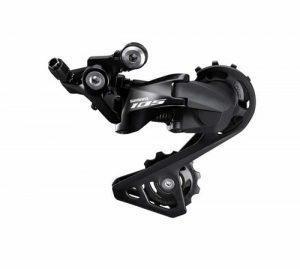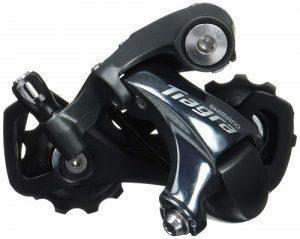When people are buying a new road bike, one of the first questions they ask is, “What is the difference between Shimano 105 and Tiagra.”
There is 1 quick and simple answer to that, and that is that Shimano 105 is a 11-speed groupset and Toagra is a 10-speed groupset.
But is there more to this difference than just the speed of the groupset?
What is a groupset?
We have talked about this before, so we’ll be brief with this answer. A groupset is a group of parts that are all made to the same quality.
A modern road bike groupset comprises of the derailleurs, shifters, brakes, chainset, bottom bracket, cassette, and chain.
The Shimano road groupset is then laid out in a hierarchy, starting from the top it is:
- Dura-Ace
- Ultegra
- 105
- Tiagra
- Sora
- Claris
If you search about you’ll find that a Tiagra groupset also works out around $100 cheaper than a Shimano 105 groupset. Is it worth saving some money to get Tiagra or are you better off spending the extra for 105?
One of the things you can’t do with Tiagra is upgrading part by part to 105. 105 as it is 11 speed you could upgrade part by part to Ultegra, or even Dura-Ace. If you fancy slowly making your bike a higher spec model, you would be better starting with 105 and working from there. Let us look at the parts within the groupsets.
STI levers

As we’ve already mentioned, the 105 shifters will allow you to shift the rear chain around 11 cogs. There is though the ability with Tiagra to get a front shifter which will allow you to use a triple chainring at the front.

105 is only available in a double. That means you’ll get a maximum of 22 gears with 105 but a maximum of 30 gears with Tiagra. There will be a weight penalty for the extra front chainring.
When we talk about weight, there is less than a 20g difference between 105 shifters and Tiagra shifters. The reason for this is because both Tiagra and 105 levers are constructed from glass-fiber reinforced plastic. You might also notice that 105 has a slightly snappier action.
Brakes
The 105 and Tiagra dual-pivot brakes are where things get interesting. The 105 brakes are actually heavier than the Tiagra brakes. That doesn’t mean you should save money here, as the 105 brakes offer a few advantages over the Tiagra brakes.
The new 105 brakes are based on the Ultegra and Dura-Ace SLR-EV Dual Pivot design. The design is a symmetrical design which allows more control and power over your braking. They also use a new pad design that is pretty grippy regardless of the conditions that you’re riding in.
The next difference is that the Tiagra brakes will work well up to a 28mm wide tire. The 105 brakes are slightly longer than they were before and this allows you the prospect of running up to 30mm wide tires.
Chainset
Both the Shimano 105 and Tiagra chainsets carry on Shimano’s love of aluminum cranks arms and a super-strong steel spindle. Given how light Shimano can make these, there are no real reasons to expect them to stop soon.
As you’d expect to compare like for like, the 105 chainset is lighter, much lighter. As we said the Tiagra version is also available in a triple, but the 105 chainset goes down to 160mm in length for those of us that are a bit shorter.
Front derailleur


The Tiagra and 105 front derailleurs are pretty similar and only differ in a couple of grams weight wise.
The other difference is that the Tiagra is 10speed and can take a large chainring up to 52 teeth. The 105 derailleur is 11 speed and can take a large chainring up to 53 teeth.
Rear derailleur
 The 105 rear derailleurs of yore used to look pretty much like the Tiagra one, now that can’t be said to be the case.
The 105 rear derailleurs of yore used to look pretty much like the Tiagra one, now that can’t be said to be the case.
Like Ultegra, the new R7000 105 derailleurs has taken on some of the features of Shimano’s mountain bike derailleurs. It is now a Shadow rear derailleur.
The use of Shadow technology helps to reduce the chance of damage to your rear derailleur, it’ll help to keep your shifting stabilized, and it also makes the rear derailleur look a little more compact. You’ll also find that it is capable of reaching 30t cogs on your cassette in its short cage version.

The Tiagra short cage will get you up to a 30t cog. In their long cage variations they will both get you up to a 34t, and if you frequent internet forums, you’ll find people have managed to take the 105 version well beyond that.

Cassette
Despite having an extra cog, the 105 cassette is again a lot lighter than the Tiagra one.
Both feature nickel-plated steel for the cogs but the 105 version uses a light aluminum spider and lock ring, and that is all there is to say about it.
Conclusion
In our article about Ultegra versus 105, we were swayed toward 105 because of its cost savings over Ultegra. When compared to Tiagra, we’ll again be swayed towards 105. There are a few reasons for this.
The brakes, the 105 brakes are so good. They work faultlessly, and they provide a lot more stopping power than the Tiagra ones. In fact, even if we built a 10-speed Tiagra groupset, we would upgrade the brakes to the 105 version. The 105 is lighter, and it does deliver crisper gear changes.
It will also be a little while longer before 11 speed becomes obsolete. With all the top tier Shimano groups being 11-speed you’ll find it easy to upgrade to them and this should help to make it easier to find parts in the future.
Eventually, Tiagra will go 11-speed. You’ll then find 10-speed parts will be harder to find, but 11-speed should still be easily sourced.
I’ve spent way more time in the bike trade than anyone should reasonably want to. In that time I’ve wanted to make cycling jargon and marketing easier to cut through to help people get the bike of their dreams.
When I’m not writing about bikes, I can be seen out bikepacking on single speed bikes or teaching kids how to ride.


